![]()
a-NAPHTHYLAMINE (1-NAPHTHYLAMINE)
b-NAPHTHYLAMINE (2-NAPHTHYLAMINE)
| Method number: | 93 | ||
| Matrix: | Air | ||
| Procedure: | Samples are collected closed-face by drawing known
volumes of air through sampling devices consisting of
| ||
| Recommended air volume and sampling rate: |
100 L at 1 L/min | ||
|
| |||
|
| |||
| Target concentration: | 1 ppb (6.9 µg/m3) | 1 ppb (5.9 µg/m3) | 1 ppb (5.9 µg/m3) |
| Reliable quantitation limit: | 1 ppt (6.9 ng/m3) | 1 ppt (5.9 ng/m3) | 1 ppt (5.9 ng/m3) |
| Standard error of estimate at the target concentration: |
5.3% | 5.5% | 5.3% |
|
| |||
| Status of method: | Evaluated method. This method has been subjected to the established evaluation procedures of the Organic Methods Evaluation Branch. | ||
| Date: January 1992 | Chemist: Carl J. Elskamp | ||
Organic Methods Evaluation Branch
OSHA Salt Lake
Technical Center
Salt Lake City, UT 84165-0200
1. General Discussion
- 1.1. Background
- 1.1.1. History 4-Aminobiphenyl, 1-naphthylamine and
2-naphthylamine are considered by OSHA to be carcinogens and the
manufacture and use of all three are covered by special regulations
published in the Code of Federal Regulations. (Refs.
Methodology based on collection with sulfuric acid-treated glass
fiber filters has previously been validated at the OSHA Salt Lake
Technical Center to determine a number of other aromatic amines.
(Refs.
1.1.2. Toxic effects (This section is for information only and should not be taken as the basis of OSHA policy.)
All three of these amines are listed as being carcinogens by OSHA
and are covered by special regulations to minimize worker exposure
by any route. (Refs.
Exposure to
It has not been established whether
2-Naphthylamine is a known human bladder carcinogen. There is
also evidence that several metabolites of
1.1.3. Workplace exposure
4-Aminobiphenyl is no longer manufactured commercially and is
used only for research purposes. It had formerly been used as a
highly efficient rubber antioxidant and as a dye intermediate. It
was reportedly an impurity in
1-Naphthylamine is used in the manufacture of dyes, condensation
colors, and rubber and in the synthesis of a large number of
chemicals such as naphthionic acid
(
2-Naphthylamine is presently used only for research purposes. It
had been used extensively as an intermediate in the manufacture of
dyes and as an antioxidant for rubber. It is present as an impurity
in
1.1.4. Physical properties and other descriptive information (Ref. 5.12.-5.14.)
|
| |||
| 4-aminobiphenyl | 1-naphthylamine | 2-naphthylamine | |
|
| |||
| CAS number: | 92-67-1 | 134-32-7 | 91-59-8 |
| molecular weight: | 169.22 | 143.2 | 143.2 |
| melting point: | 53°C | 50°C | 111-113°C |
| boiling point: | 191°C (2 kPa) | 301°C | 306°C |
| description: | colorless crystals turning dark upon oxidation | colorless crystals which darken in air to a
|
colorless crystals which darken in color; unpleasant purple color |
| solubility: | very slightly soluble in cold water; soluble in hot water
and |
0.16% dissolves in water at 25°C; freely soluble in alcohol, ehter an many other organic solvents | soluble in hot water, alcohol, ether and many other organic solvents |
| structural formula: | |||
| synonyms: | |||
The analyte air concentrations throughout this method are based on the recommended sampling and analytical parameters. Air concentrations listed in ppb and ppt are referenced to 25°C and 101.3 kPa (760 mmHg). Although the derivatives of the amines are analyzed, the equivalent masses of the amines are listed throughout the method.
- 1.2. Limit defining parameters
- 1.2.1. Detection limit of the analytical procedure
The detection limits of the analytical procedure are 10.5, 8.9,
and 8.9 fg per injection for
1.2.2. Detection limit of the overall procedure
The detection limits of the overall procedure are 0.677, 0.583,
and 0.598 ng per sample for
1.2.3. Reliable quantitation limit
The reliable quantitation limits are 0.677, 0.583, and 0.598 ng
per sample for
The reliable quantitation limits and detection limits reported in this method are based upon optimization of the instrument for the smallest possible amount of analyte. When the target concentration of an analyte is exceptionally higher than these limits, they may not be attainable at the routine operating parameters.
1.2.4. Instrument response to the analyte
The instrument response over concentration ranges representing 0.5 to 2 times the target concentrations is linear for the three analytes. (Section 4.4.)
1.2.5. Recovery
The recoveries of
1.2.6. Precision (analytical method only)
The pooled coefficients of variation obtained from replicate
injections of analytical standards at 0.5, 1, and 2 times the target
concentrations are 0.014, 0.013, and 0.014 for
1.2.7. Precision (overall procedure)
The precisions at the 95% confidence level for the 15-day storage
tests are ±10.5, ±10.8, and ±10.3% for
1.2.8. Reproducibility
Six samples, spiked by liquid injection, and a draft copy of this procedure were given to a chemist unassociated with this evaluation. The samples were analyzed after 2 days of storage at approximately 0°C. No individual sample result deviated from its theoretical value by more than the corresponding precision of the overall procedure as reported in Section 1.2.7. (Section 4.8.)
1.3. Advantages
- 1.3.1. The acid-treated filter provides a convenient method of
sampling for a number of aromatic amines.
1.3.2. The analysis is rapid, sensitive, and precise.
2. Sampling Procedure
- 2.1. Apparatus
- 2.1.1. Samples are collected using a personal sampling pump that
can be calibrated within ±5% of the recommended flow rate with the
sampling device attached.
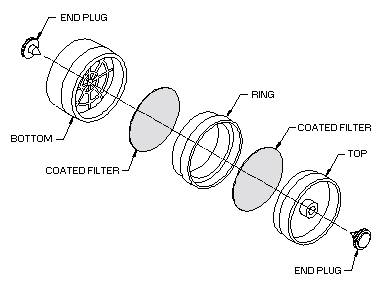 2.1.2. Samples are collected
2.1.2. Samples are collected
2.1.3. Small sealable vials with volumes of at least 7 mL are needed for sample shipment and storage. Glass scintillation vials with caps containing Teflon liners are recommended.
2.2. Reagents
Deionized water is needed for addition to the vials described in Section 2.1.3.
2.3. Sampling technique
- 2.3.1. Remove the plastic end plugs from the sampling device
immediately before sampling.
2.3.2. Attach the sampling device to the sampling pump with flexible tubing and place the device in the employee's breathing zone.
2.3.3. Immediately after sampling, seal the sampling device with plastic end plugs until the filters are transferred to vials containing deionized water.
2.3.4. At some convenient time within 10 h of sampling, carefully remove the filters from the cassettes and individually transfer them to separate vials. Add approximately 2 mL of deionized water to each vial. The water can be added before or after the filters are transferred.
2.3.5. Seal and identify each vial with an OSHA Form 21.
2.3.6. Submit at least one blank with each sample set. Handle the blanks in the same manner as the air samples, but draw no air through them.
2.3.7. Record the volume of air sampled (in liters) for each sample, along with any potential interferences.
2.4. Collection efficiency
Collection efficiency studies were conducted by drawing humid air
through a sampling device that was attached to a glass
2.5. Extraction efficiency
- 2.5.1. The average extraction efficiencies from six filters for
each amine spiked at the target concentration are 99.6%, 99.5%, and
100.0% for
2.5.2. The stability of extracted and derivatized samples was
verified by reanalyzing the extraction efficiency samples 24 h later
using fresh standards. The average recoveries for the reanalyzed
samples are 100.9%, 99.5%, and 101.0% for
2.6. Recommended air volume and sampling rate
- 2.6.1. The recommended air volume is 100 L.
2.6.2. The recommended sampling rate is 1 L/min.
2.6.3. When short-term samples are required, the reliable
quantitation limits will be larger. For example, the reliable
quantitation limit for
2.7. Interferences (sampling)
- 2.7.1. Any compound in the sampled air that will react with the
sulfuric acid on the treated filters or with the collected analyte
is a potential sampling interference.
2.7.2. Suspected interferences should be reported to the laboratory with submitted samples.
2.8. Safety precautions (sampling)
- 2.8.1. Attach the sampling equipment to the employees so it will
not interfere with work performance or safety.
2.8.2. Follow all safety procedures that apply to the work area being sampled.
3. Analytical Procedure
- 3.1. Apparatus
- 3.1.1. A GC equipped with an electron capture detector. A
3.1.2. A GC column capable of separating the amine derivatives
from the solvent and interferences. A
3.1.3. An electronic integrator or some other suitable means of measuring peak areas or heights. A Waters 860 Networking Computer System was used in this evaluation.
3.1.4. Small resealable vials with Teflon-lined caps capable of holding 4 mL.
3.1.5. A dispenser or pipet for toluene capable of delivering 2.0 mL.
3.1.6. Pipets (or repetitive pipets with plastic or Teflon tips) capable of delivering 1 mL for dispensing the sodium hydroxide and buffer solutions.
3.1.7. A repetitive pipet to deliver 25 µL of heptafluorobutyric acid anhydride (HFAA).
3.1.8. Disposable pipets to transfer the toluene layers after the samples are extracted.
3.1.9. A laboratory centrifuge.
3.2. Reagents
- 3.2.1. Saturated and 0.5 N NaOH solutions, prepared from reagent
grade NaOH.
3.2.2. Toluene. American Burdick and Jackson "High Purity Solvent" brand toluene was used.
3.2.3. Heptafluorobutyric acid anhydride (HFAA). HFAA from Aldrich Chemical Company was used.
3.2.4. Phosphate buffer, prepared by dissolving 136 g of reagent grade potassium dihydrogen phosphate in approximately 900 mL of deionized water, adjusting the pH to 7.0 with saturated sodium hydroxide solution, and diluting to 1 L with deionized water.
3.2.5. 4-Aminobiphenyl,
3.3. Standard preparation
- 3.3.1. CAUTION. THESE AROMATIC AMINES ARE
CARCINOGENIC. Restrict use of pure compounds and
concentrated standards to regulated areas. Prepare concentrated
stock standards by diluting the pure amines with toluene. Prepare
analytical standards by injecting microliter amounts of diluted
stock standards into vials that contain 2.0 mL of toluene. For
example, prepare a 1.204 µg/µL stock standard of
3.3.2. Add 25 µL of HFAA to each vial. Recap and shake the vials for 10 s.
3.3.3. After allowing 10 min for the derivatives to form, add 1 mL of buffer to each vial to destroy the excess HFAA and to extract the heptafluorobutyric acid that is formed.
3.3.4. Recap and shake the vials for 10 s.
3.3.5. After allowing the two layers to separate, analyze the toluene (upper) layer of each standard by GC.
3.3.6. Bracket sample concentrations with analytical standard concentrations. If sample concentrations are higher than the upper range of prepared standards, prepare additional standards to ascertain detector response.
3.4. Sample preparation
- 3.4.1. The sample filters are received in vials containing
deionized water.
3.4.2. Add 1 mL of 0.5 N NaOH and 2.0 mL of toluene to each vial.
3.4.3. Recap and shake the vials for 10 min.
3.4.4. Centrifuge the vials at 2500 rpm for 10 min.
3.4.5. Transfer approximately 1 mL of the toluene (upper) layer of each sample to separate vials with clean disposable pipets.
3.4.6. Add 25 µL of HFAA to each vial containing the transferred toluene layer. Recap and shake the vials for 10 s.
3.4.7. After allowing 10 min for the derivatives to form, add 1 mL of buffer to each vial to destroy the excess HFAA and to extract the heptafluorobutyric acid that is formed.
3.4.8. Recap and shake the vials for 10 s.
3.4.9. After allowing the two layers to separate, analyze the toluene (upper) layer of each sample by GC.
3.5. Analysis
- 3.5.1. GC conditions and information
| zone temperatures: | column, 180°C injector, 250°C detector, 300°C |
| gas flows: | column, 1.6 mL/min hydrogen (32 kPa head pressure) make up, 67 mL/min nitrogen |
| injection volume: | 1.0 µL |
| split ratio: | 33:1 |
| column: | SPB-5, 1.0-µm df, 15-m × 0.32-mm i.d. fused silica (Supelco, Inc.) |
| retention times of derivatives: |
|
| chromatogram at 1× the target concentrations: | |
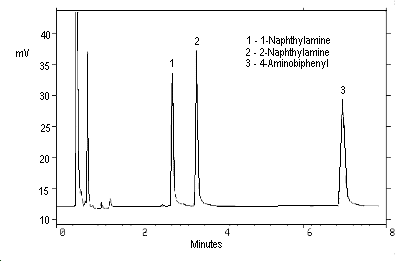 | |
3.5.2. Construct a calibration curve by plotting response (peak areas or heights) of standard injections versus micrograms of analyte per sample. Bracket sample concentrations with standards.
3.6. Interferences (analytical)
- 3.6.1. Any compound that elutes in the same general time as the
HFAA derivative of the amine of interest is a potential
interference. Suspected interferences reported to the laboratory
with submitted samples by the industrial hygienist must be
considered before samples are derivatized.
3.6.2. GC parameters may be changed to possibly circumvent interferences.
3.6.3. Retention time on a single column is not considered proof of chemical identity. Analyte identity should be confirmed by GC/MS if possible.
3.7. Calculations
The analyte concentration for samples is obtained from the calibration curve in micrograms of analyte per sample. The back filter is analyzed to determine if there was any breakthrough from the front filter during sampling. If any analyte is found on any back filter, that amount is added to the amount found on the corresponding front filter. The combined amount is then corrected by subtracting the total amount (if any) found on the corresponding blank filters. The air concentrations are calculated using the following formulae. Extraction efficiency corrections are not necessary because the extraction efficiencies are essentially 100% for all three analytes.
| µg/m3 = | (µg analyte per sample) (1000)
(L of air sampled) |
ppb = (µg/m3)(24.46) / (molecular weight of analyte)
- where 24.46 is the molar volume at 25°C and 101.3 kPa (760 mmHg)
and molecular weights are:
3.8. Safety precautions (analytical)
- 3.8.1. CAUTION. THESE AROMATIC AMINES ARE
CARCINOGENIC. Restrict use of pure compounds and
concentrated standards to regulated areas. Avoid skin contact and
inhalation of all chemicals.
3.8.2. Restrict the use of all chemicals to a fume hood if possible.
3.8.3. Wear safety glasses and a lab coat at all times while in the lab area.
4. Backup Data
- 4.1. Detection limit of the analytical procedure
| The injection volume (1 µL with a 33:1 split ratio)
listed in Section 3.5.1. was used in the determination of the
detection limits of the analytical procedure. The detection
limits of 10.5, 8.9, and 8.9 fg per injection were determined by
analyzing dilute standards equivalent to 0.677, 0.583, and 0.598
ng per sample for |
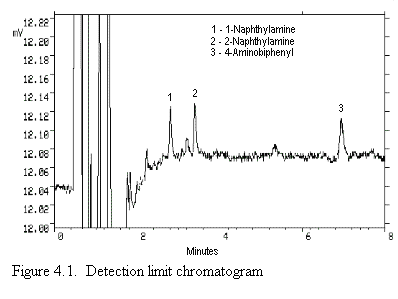
|
4.2. Detection limit of the overall procedure
| The detection limits of the overall procedure were
determined by analyzing filters spiked with 0.677, 0.583, and
0.598 ng of |
| |||||||||||||||||||
|
| ||||||||||||||||||||||||||||||||||||||
4.3. Reliable quantitation limit
| The reliable quantitation limits were determined by
analyzing filters spiked with 0.677, 0.583, and 0.598 ng of
|
| |||||||||||||||
|
| |||||||||||||||||||||||||||||||||||||||||||
4.4. Instrument response to the analyte
The instrument response to the analytes over the range of 0.5 to 2
times the targetconcentrations was determined from multiple injections
of analytical standards. The response is linear for the three analytes
with slopes (in area counts per micrograms of analyte per sample) of
190400, 123200, and 172400 for
|
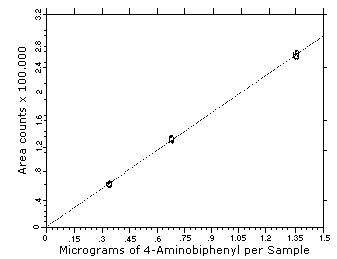 Figure 4.4.1. Instrument response to | |||||||||||||||||||||||||
|
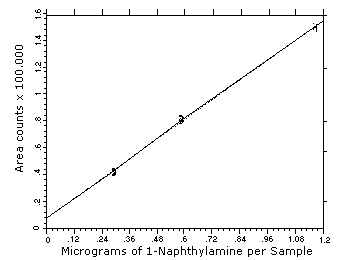 Figure 4.4.2. Instrument response to | |||||||||||||||||||||||||
|
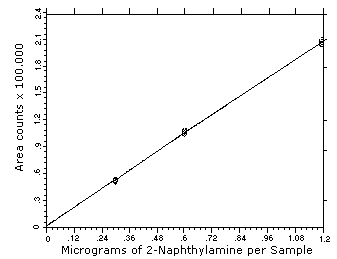 Figure 4.4.3. Instrument response to | |||||||||||||||||||||||||
4.5. Storage test
Thirty-six storage samples were generated by spiking sulfuric
|
| |||||||
| days of storage |
% recovery (refrigerated) |
% recovery (ambient) | |||||
|
| |||||||
| 0 0 3 6 9 12 15 |
97.3 96.4 95.4 98.8 100.8 95.7 101.9 |
94.5 99.6 100.1 93.2 85.5 97.9 99.7 |
96.9 100.4 96.6 99.5 101.6 97.3 100.8 |
97.3 96.4 98.7 98.2 100.3 98.9 102.5 |
94.5 99.6 97.3 99.2 97.7 98.6 97.3 |
96.9 100.4 100.7 99.8 102.6 98.2 98.2 | |
|
| |||||||
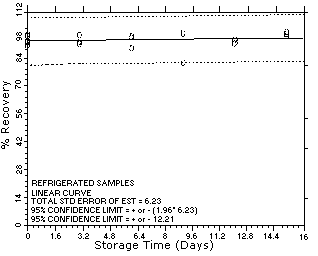
Figure 4.5.1.1.
Refrigerated 4-aminobiphenyl storage samples. 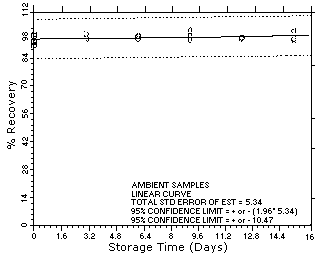
Figure 4.5.1.2. Ambient 4-aminobiphenyl storage samples.
|
| |||||||
| days of storage |
% recovery (refrigerated) |
% recovery (ambient) | |||||
|
| |||||||
| 0 0 3 6 9 12 15 |
96.4 98.1 92.5 99.5 97.0 95.2 100.0 |
95.1 100.7 98.8 94.2 83.4 95.9 99.2 |
97.1 100.5 93.5 100.0 98.3 97.0 98.3 |
96.4 98.1 89.6 91.6 88.6 89.6 83.2 |
95.1 100.7 90.6 92.3 87.7 87.0 82.7 |
97.1 100.5 93.5 91.1 90.3 88.9 80.8 | |
|
| |||||||
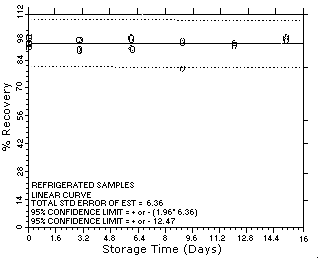
Figure 4.5.2.1.
Refrigerated 1-naphthylamine storage samples. 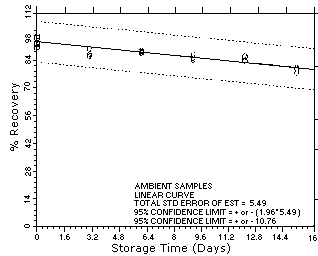
Figure 4.5.2.2. Ambient 1-naphthylamine storage samples.
|
| |||||||
| days of storage |
% recovery (refrigerated) |
% recovery (ambient) | |||||
|
| |||||||
| 0 0 3 6 9 12 15 |
96.8 97.3 93.8 98.8 96.6 96.5 99.8 |
95.0 100.3 99.5 92.6 84.6 97.3 98.8 |
95.8 99.8 94.7 99.3 100.2 98.1 98.1 |
96.8 97.3 96.5 98.0 97.3 98.3 97.6 |
95.0 100.3 95.7 98.0 96.5 97.0 95.6 |
95.8 99.8 99.2 98.6 99.6 97.0 94.0 | |
|
| |||||||
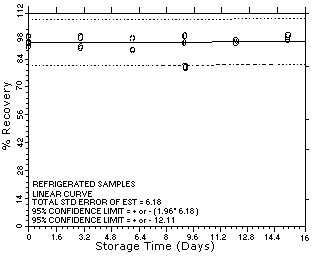
Figure 4.5.3.1.
Refrigerated 2-naphthylamine storage samples. 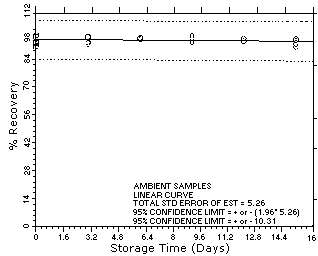
Figure 4.5.3.2. Ambient 2-naphthylamine storage samples.
| 4.6. Precision (analytical method only)
The precision of the analytical method for each analyte is
the pooled coefficient of variation determined from replicate
injections of standards. The coefficients of variation (CV) are
calculated from the data from Tables |
| ||||||||||||||||||||
|
| ||||||||||||||||||||||||||||||||||||||||
4.7. Precision (overall procedure)
The precision of the overall procedure is determined from the storage data. The determination of the standard error of estimate (SEE) for a regression line plotted through the graphed storage data allows the inclusion of storage time as one of the factors affecting overall precision. The SEE is similar to the standard deviation, except it is a measure of dispersion of data about a regression line instead of about a mean. It is determined with the following equation:

| where | |
| n = k = k = |
total no. of data points 2 for linear regression 3 for quadratic regression |
| Yobs = | observed % recovery at a given time |
| Yest = | estimated % recovery from the regression line at the same given time |
An additional 5% for pump error is added to the SEE by the addition
of variances. The precision at the 95% confidence level is obtained by
multiplying the SEE (with pump error included) by 1.96 (the
4.8. Reproducibility
|
| |||
| µg spiked | µg found | % found | % difference |
|
| |||
| 0.677 0.677 0.677 0.677 0.677 0.677 |
0.679 0.674 0.640 0.631 0.630 0.633 |
100.3
99.6 94.5 93.2 93.1 93.5 |
+0.3 -0.4 -5.5 -6.8 -6.9 -6.5 |
|
| |||
Samples were prepared by injecting microliter quantities of
standards onto acid-treated filters, assembling the filters into
cassettes, and drawing 100 L of 80% relative humidity air through the
samplers at 1 L/min. The filters were then transferred to separate
vials containing 2 mL of deionized water and stored for 2 days at 0°C
before being analyzed by another chemist. No individual sample result
deviated from its theoretical value by more than the corresponding
precision of the overall procedure. The precisions of the overall
procedure are ±10.5%, ±10.8%, and ±10.3% for
|
| ||||
| µg spiked |
µg found |
% found |
% difference | |
|
| ||||
| 0.583 0.583 0.583 0.583 0.583 0.583 |
0.628 0.613 0.592 0.604 0.602 0.581 |
107.7 105.1 101.5 103.6 103.3 99.7 |
+7.7 +5.1 +1.5 +3.6 +3.3 -0.3 | |
|
| ||||
|
| ||||
| µg spiked |
µg found |
% found |
% difference | |
|
| ||||
| 0.598 0.598 0.598 0.598 0.598 0.598 |
0.583 0.609 0.560 0.560 0.561 0.559 |
97.5 101.8 93.6 93.6 93.8 93.5 |
-2.5 +1.8 -6.4 -6.4 -6.2 -6.5 | |
|
| ||||
4.9. Extraction efficiency
| Six sample filters were spiked with the target concentration
amounts by liquid injection (0.677, 0.583, and 0.598 µg
of |
| |||||||||||||||
|
| ||||||||||||||||||||||||||||||||
5. References
- 5.1. "Code of Federal Regulations", 29 CFR 1910.1011, Ch. XVII
5.2. ibid. 29 CFR 1910.1004.
5.3. ibid. 29 CFR 1910.1009.
5.4. "NIOSH Manual of Analytical Method", 3rd ed. Vol. 3; U.S. Department of Health and Human Services, Public Health Service, Centers for Disease Control, National Institute for Occupational Safety and Health, Division of Physical Sciences and Engineering; Cincinnati, OH, 1985, Method 5518, DHHS (NIOSH).
5.5. "OSHA Analytical Methods Manual", 2nd ed.; U.S. Department of Labor, Occupational Safety and Health Administration; OSHA Analytical Laboratory: Salt Lake City, UT, 1990; Method 57; American Conference of Governmental Industrial Hygienists (ACGIH): Cincinnati, OH, Publication No. 4542.
5.6. ibid. Method 65.
5.7. ibid. Method 71.
5.8. ibid. Method 73.
5.9. ibid. Method 78.
5.10. Elskamp, C.J. "OSHA Method No. 87; m-, o-, and p-Phenylenediamine", OSHA Salt Lake Technical Center, unpublished, Salt Lake City, UT 84165, February 1991.
5.11. "1991-1992 Threshold Limit Values for Chemical Substances and Physical Agents and Biological Exposure Indices"; American Conference of Governmental Industrial Hygienists: Cincinnati, OH, 1991.
5.12. "IARC Monographs on the Evaluation of the Carcinogenic Risk
of Chemicals to Man", International Agency for Research on Cancer:
Lyon, 1972; Vol. 1, pp
5.13. "IARC Monographs on the Evaluation of the Carcinogenic Risk
of Chemicals to Man: Some aromatic amines, hydrazine and related
substances,
5.14. ibid. pp 97-111.